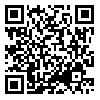Volume 25, Issue 96 (3-2025)
refahj 2025, 25(96): 97-126 |
Back to browse issues page
Download citation:
BibTeX | RIS | EndNote | Medlars | ProCite | Reference Manager | RefWorks
Send citation to:



BibTeX | RIS | EndNote | Medlars | ProCite | Reference Manager | RefWorks
Send citation to:
Mohammadi E. (2025). How the disadvantaged and socially vulnerable people are treated in legal documents( A content analysis). refahj. 25(96), : 4 doi:10.32598/refahj.25.96.4503.1
URL: http://refahj.uswr.ac.ir/article-1-4313-en.html
URL: http://refahj.uswr.ac.ir/article-1-4313-en.html
Abstract: (1704 Views)
Introduction: The aim of the research was to identify the position of socially vulnerable and disadvantaged people in legal documents in terms of how their needs have been addressed and what approaches were used for dealing with their problems.
Method: A quantitative content analysis method was used. With keywords such as women headed households, working children, criminals, prisoners, drug addicts, elderly, disabled people, all approved legal documents available on the website of the Majlis Research Center were reviewed. At first, 470 legal documents were obtained between 1300 and 1400, and according to the entry and exit criteria, 108 legal documents were identified and all of them were included in the research.
Findings:The results showed that among the socially disadvantaged groups, prisoners and among the socially vulnerable groups, women headed households and the people with disabilities have attracted the most attention and this attention has reached its highest level in the 1380s. Among the needs of these groups, mainly legal needs (33%) and then healthcare (19%) have been considered in the documents. The other needs, including housing, employment and marriage, have been seriously considered only at the 1380s. Social work was weakly presented in legal documents. The service approaches are mainly focused on financial services (24%) and medical services (23%), and other social approaches including Empowerment and community-oriented have not been considered in working with the complex issues of these people.
Discussion: In legal documents, the predominance of legal and medical approaches in regard to the needs and approaches of dealing with needs of vulnerable groups is more prominent, and the social perspectives are less used.
Method: A quantitative content analysis method was used. With keywords such as women headed households, working children, criminals, prisoners, drug addicts, elderly, disabled people, all approved legal documents available on the website of the Majlis Research Center were reviewed. At first, 470 legal documents were obtained between 1300 and 1400, and according to the entry and exit criteria, 108 legal documents were identified and all of them were included in the research.
Findings:The results showed that among the socially disadvantaged groups, prisoners and among the socially vulnerable groups, women headed households and the people with disabilities have attracted the most attention and this attention has reached its highest level in the 1380s. Among the needs of these groups, mainly legal needs (33%) and then healthcare (19%) have been considered in the documents. The other needs, including housing, employment and marriage, have been seriously considered only at the 1380s. Social work was weakly presented in legal documents. The service approaches are mainly focused on financial services (24%) and medical services (23%), and other social approaches including Empowerment and community-oriented have not been considered in working with the complex issues of these people.
Discussion: In legal documents, the predominance of legal and medical approaches in regard to the needs and approaches of dealing with needs of vulnerable groups is more prominent, and the social perspectives are less used.
Article number: 4
Type of Study: orginal |
Received: 2024/02/15 | Accepted: 2025/01/21 | Published: 2025/04/4
Received: 2024/02/15 | Accepted: 2025/01/21 | Published: 2025/04/4
Send email to the article author
| Rights and permissions | |
 |
This work is licensed under a Creative Commons Attribution-NonCommercial 4.0 International License. |








